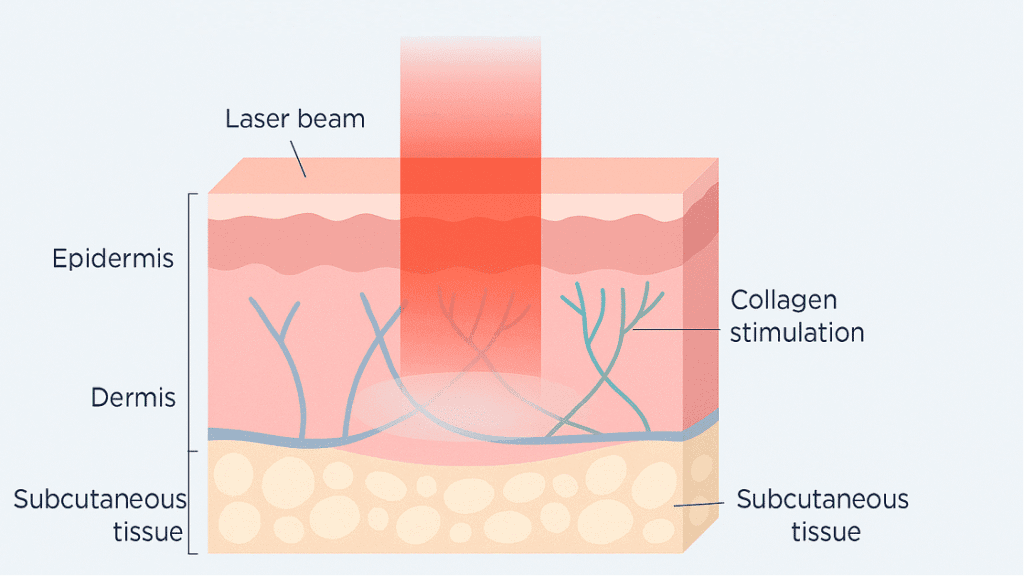1. Introduction
The pursuit of smoother skin has sparked major innovations in laser technology—none more groundbreaking than the picosecond laser. Unlike traditional lasers that use heat, pico lasers deliver ultra-short pulses to create a powerful photoacoustic effect that renews skin at the cellular level. This non-invasive treatment effectively targets acne scars, enlarged pores, wrinkles, and uneven texture, offering visible results with minimal downtime. Safe for all skin types, picosecond lasers represent a new era in skin rejuvenation. This guide breaks down how the technology works, its texture-refining benefits, and the science behind its growing popularity—empowering you to make informed choices in your skincare journey.
2. How Pico Laser Improves Skin Texture: Scientific Mechanisms Explained
The revolutionary approach of picosecond laser technology lies in its unique ability to deliver energy in extraordinarily brief pulses, creating specific biological responses that promote comprehensive skin texture improvement. Unlike conventional laser systems that operate through photothermal mechanisms, pico lasers primarily utilize photoacoustic and photomechanical effects to achieve remarkable skin transformation results.
2.1 Collagen and Elastin Boost via Photoacoustic Energy
Pico lasers deliver ultra-short pulses that generate photoacoustic waves, creating controlled micro-injuries deep within the skin. These acoustic waves activate fibroblasts in the dermis, triggering collagen and elastin production—key proteins that improve firmness and texture. This neocollagenesis process continues for months, delivering gradual improvements without thermal damage. Unlike traditional lasers, pico lasers minimize inflammation and downtime by targeting tissue mechanically rather than thermally, offering safer collagen remodeling across all skin types.

2.2 Stimulating Microscopic Cellular Renewal for Smooth Skin
The photoacoustic effect of pico lasers initiates microscopic tissue disruption, sparking cellular repair and renewal. This encourages keratinocyte turnover and reorganization of the skin’s upper layers, smoothing rough texture and surface irregularities. New capillary formation improves blood flow, enhancing nutrient delivery for lasting results. The treatment also promotes collagen fiber reorganization, creating a denser and more uniform dermal matrix, leading to visibly smoother, healthier-looking skin over time.
2.3 Non-Ablative Dermal Remodeling for All Skin Types
Pico laser’s non-ablative mechanism remodels skin from within without damaging the surface, making it ideal for all Fitzpatrick skin types. Its ultra-short pulses avoid thermal injury, minimizing risks like hyperpigmentation, especially in darker skin tones. Because the epidermis stays intact, healing is faster with virtually no downtime. This makes pico laser suitable for sensitive skin and busy individuals, offering deep tissue renewal without the extended recovery seen with traditional ablative lasers.
2.4 Shrinking Pores and Enhancing Surface Clarity
Pico laser tightens the skin’s structure around hair follicles, reducing pore size and improving clarity. By stimulating collagen in perifollicular zones, the skin becomes firmer and more even. The treatment also helps balance oil production and speeds up cell turnover, preventing clogged pores. With continued use, it refines the skin surface, removes dullness, and enhances tone uniformity—revealing clearer, smoother, and more radiant skin.
3. Skin Texture Problems Pico Laser Fixes Best
The versatility of picosecond laser technology makes it an ideal solution for addressing a wide range of skin texture concerns. Clinical evidence and patient outcomes demonstrate exceptional effectiveness across multiple dermatological conditions, offering hope for individuals who have struggled with persistent textural irregularities despite trying various treatment modalities.
3.1 Acne Scars & Inflammatory Roughness
Pico laser effectively treats both atrophic (like icepick and boxcar) and hypertrophic acne scars by breaking down scar tissue and stimulating collagen remodeling. Its precise photoacoustic waves promote smoother skin by reorganizing damaged fibers while preserving surrounding healthy tissue. It also helps reduce inflammation and normalize skin turnover for active or recent acne, improving roughness. A study with six treatments showed high satisfaction among participants. Over multiple sessions, patients typically experience visible scar softening and improved texture without significant downtime.
3.2 Sun-Damaged and Uneven Skin Texture
Chronic sun exposure causes rough texture and collagen breakdown. Pico laser reverses this damage by destroying degraded fibers and stimulating new collagen and elastin production. Studies show significant improvements in texture and pigmentation after six sessions. The treatment also addresses uneven tone and restores elasticity while preserving fragile sun-damaged skin. Its precise, non-thermal action allows for safe, gradual improvements with natural-looking results and minimal risk, making it ideal for treating photoaged, delicate skin.
3.3 Fine Lines and Early Aging Signs
Pico laser targets early aging signs by boosting collagen and accelerating cell turnover, improving texture and reducing fine lines. It’s especially effective on delicate areas like the eyes and mouth, firming the skin without causing trauma. The treatment promotes smoother, more resilient skin with subtle, progressive results. Because it’s non-ablative, patients enjoy visible anti-aging benefits with no downtime. This makes it an appealing option for maintaining a youthful appearance without disrupting daily life.
3.4 Enlarged Pores and Surface Dullness
Enlarged pores and dullness often go hand-in-hand. Pico laser tightens pores by stimulating collagen around follicles and improves clarity by enhancing cell turnover. It also boosts microcirculation, helping skin look brighter and more refreshed. By exfoliating dead cells and reorganizing collagen, it smooths texture and restores radiance. The combined effects create visibly refined skin with better tone and vitality. Many patients report easier makeup application and greater confidence in their bare skin after treatment.

4. Ideal Candidates for Pico Laser Skin Texture Treatment
Determining candidacy for pico laser treatment involves careful assessment of individual skin concerns, medical history, and treatment goals. The versatility and safety profile of picosecond technology make it suitable for a broad range of patients, though certain characteristics indicate particularly favorable outcomes.
4.1 People with Acne Scarring
Pico laser is ideal for those with mild to moderate acne scars, especially mixed scar types like boxcar and rolling scars. It’s safe for darker skin tones due to low thermal damage, minimizing the risk of pigmentation. Candidates should have realistic expectations and commit to multiple sessions for visible improvement. Active acne should be controlled first to avoid new scars. While results are significant, full scar removal may need combination therapies. Post-treatment care and sun protection are key for lasting benefits.
4.2 Patients with Photodamaged Skin
Those with sun-damaged, rough, and uneven skin make great candidates for pico laser. It treats texture issues, pigment spots, and early aging signs simultaneously, offering noticeable improvement with little downtime. Ideal patients are committed to sun protection to prevent further damage. Pico laser suits individuals who haven’t seen results from topical treatments. Multiple sessions may be needed for severe damage, but improvements in tone, elasticity, and smoothness are worth the effort.
4.3 Oily Skin with Large Pores
People with oily skin and large pores often see visible benefits from pico laser. It tightens pores by boosting collagen and helps regulate oil production. Ideal candidates have mild to moderate pore issues and no active acne. The treatment enhances cell turnover and supports better skin clarity. Those frustrated with limited results from skincare products often find pico laser effective. Consistency, multiple sessions, and good aftercare are essential for lasting results and improved skin texture.
4.4 Aging Skin Seeking Non-Invasive Options
Pico laser is great for those with early to moderate signs of aging who prefer non-invasive treatments. It stimulates collagen without damaging the skin, improving fine lines, texture, and firmness. Best suited for patients wanting gradual, natural results with no downtime. It’s especially appealing for those with busy lifestyles or concerns about aggressive procedures. With its strong safety profile and compatibility with many skin types, pico laser is a reliable option for gentle rejuvenation.
5. Scientific & Clinical Studies on Pico Laser Texture Results
The efficacy of picosecond laser technology for skin texture improvement is supported by extensive clinical research demonstrating consistent, measurable outcomes across diverse patient populations. Scientific evidence provides the foundation for understanding treatment expectations and optimizing protocols for maximum benefit.
5.1 Dermatologist-Endorsed Outcomes
Clinical studies consistently show that pico laser significantly improves skin texture, including roughness, pore size, and overall quality. Dermatologists highlight measurable increases in collagen density using imaging techniques, with results continuing months after treatment. Histology confirms better collagen organization and improved dermal structure. Standardized grading systems show notable gains in smoothness, pore visibility, and texture, aligning with high patient satisfaction. These findings confirm pico laser’s reliability for non-invasive texture improvement, making it a go-to option for professionals seeking safe, effective results supported by both clinical and scientific data.
5.2 Patient-Reported Improvements
Patients report visible texture improvement within the first 2–3 weeks and continue to see progress during the treatment series. Most note softer, smoother skin and reduced reliance on makeup. The gradual changes feel natural and enhance confidence. Long-term follow-ups show sustained satisfaction, especially when patients maintain skincare and sun protection. The combination of early improvements and lasting enhancement leads to high satisfaction rates, often outperforming traditional texture treatments. Pico laser’s gentle, progressive approach appeals to patients wanting real results without looking overdone or needing recovery time.
5.3 Optimal Treatment Frequency and Timeline
Studies recommend 3–6 sessions spaced 4–6 weeks apart for best results. This schedule supports collagen remodeling while minimizing downtime. Most patients notice ongoing improvements over 3 to 6 months as deeper skin layers build new collagen. Maintenance treatments every 6–12 months help preserve results and promote gradual enhancement. Treatment plans should be tailored to individual skin needs, response, and goals for optimal outcomes. This structured yet customizable approach ensures sustained improvement in skin texture with minimal risk, making it both practical and effective for long-term skin rejuvenation.

6. Pico Laser Aftercare: Healing, Redness & Results Timeline
After pico laser treatment, mild redness and swelling may occur but usually subside within 24–48 hours. Since the skin surface stays intact, downtime is minimal. Avoid sun exposure and use broad-spectrum sunscreen to protect healing skin. Gentle cleansing, moisturizing, and avoiding exfoliants for a week support recovery. Skin starts feeling smoother and looking brighter within 2–3 weeks as collagen builds. Continued improvement follows for months. Long-term care includes sun protection, proper skincare, and occasional maintenance sessions. Patients who follow aftercare instructions typically enjoy better, longer-lasting results with reduced risk of complications.
7. Conclusion: Why Pico Laser Deserves a Spot in Your Skincare Plan
Pico laser offers a non-invasive, low-risk solution for skin texture concerns like acne scars, sun damage, and enlarged pores. Its safety across skin tones and minimal downtime make it ideal for busy individuals. Clinical research confirms its effectiveness, while patients report natural-looking, long-term results. The technology improves skin quality through gradual collagen stimulation, meeting modern aesthetic goals without harsh procedures. For those seeking visible, lasting improvement with minimal hassle, pico laser provides a science-backed, efficient, and versatile option worth adding to any skincare regimen.
8. FAQs: What Most Patients Ask Before Starting
Not at all—just a bit flushed. Most people experience slight redness or swelling, like a mild sunburn, that fades within a day or two. You can usually go back to work or social events right away.
Many patients notice an initial glow within 7–10 days, with texture and clarity improving over several weeks as collagen rebuilds. The magic is progressive and natural—not overnight, but worth the wait.
Yes! Pico lasers are multitaskers. They target multiple issues—scars, pigmentation, texture—in one treatment plan, making them ideal for people with layered concerns.
Pico laser is a go-to for darker skin tones because it uses less heat than traditional lasers, reducing the risk of post-inflammatory hyperpigmentation.
Most describe the sensation as tiny rubber band snaps or warm pinpricks. It’s quick and tolerable—and numbing cream can make it even easier.
Not drastically. Just go gentle for a week—no scrubs, acids, or peels. Stick to hydrating products and sunscreen. Your skin will thank you.








